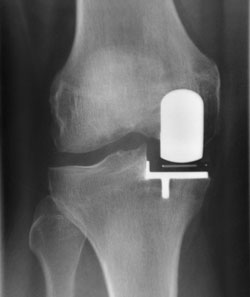Lower rate of radiolucency seen in uncemented vs cemented UKA
Unicompartmental knee arthroplasty performed without cement results in better fixation and shows complication rates similar to cemented procedures, according to results of a multicenter study presented at the American Academy of Orthopaedic Surgeons 2012 Annual Meeting.
“The complication rate, survival rate and functional outcome for cementless Oxford [unicompartmental knee arthroplasty] UKA are equivalent to that of cemented,” study investigator David W. Murray, MD, FRCS(C), said during his presentation. “In the cementless group, we saw no complete radiolucencies at 1 year, which was significantly lower than in the cemented group, suggesting improved fixation. We believe if you have good fixation at 1 year, you should get good long-term fixation. We did not identify any additional contraindications for cementless components compared to cemented.”
He added, “Cementless fixation is safe and effective and can be generally used, but it not yet FDA-approved.”

AP radiograph of a patient with cementless medial unicompartmental replacement.
Image: Murray DW
For their study, Murray and colleagues sought to determine the rate of complications with cementless UKA, to identify the contraindications for the procedure and to compare the radiolucencies and functional outcomes between cemented and cementless procedures.
They studied 1,000 consecutive patients with a minimum 1-year follow-up who underwent cementless UKA at three centers in Christchurch, New Zealand; Belfast, Northern Ireland; and Oxford, England. They compared the group to 1,000 patients who underwent cemented UKA in Oxford. All of the patients had full-thickness cartilage loss in the medial compartment with intact ACLs. Both groups received the Oxford knee replacement (Biomet, Warsaw, Ind.) and underwent standard surgical techniques and rehabilitation. Each patient had X-rays that were accurately aligned with the components and bone implant interface at 1 year. To achieve accurate alignment of the X-ray most were taken fluoroscopically, Murray said.
The researchers lost 1% of patients to follow-up and 1.6% of patients died during the study period.
They found similar improvements in the clinical scores in the cemented and cementless groups.
They discovered partial tibial radiolucencies in 6% of the cementless group and 30% of cemented cohort. Complete radiolucencies at the tibial bone-implant interface were found in 0.5% of the cementless group and 30% of the cemented cohort.
Overall, 1.9% of patients underwent re-operation for bearing dislocations, progressive arthritis, perioperative tibial plateau fractures, infections, late fracture from trauma and avascular necrosis. The re-operations included four revisions to total knees, five unicompartmental arthroplasties and 10 surgical procedures that allowed for prostheses retention. The researchers found no significant difference in the complication rates between the cohorts.
“If we consider all re-operations to be failures, [then] the 7-year survival rate for cementless components is 97%, which is not significantly different from the survival rate for cemented components,” Murray said. – by Renee Blisard
Reference:
- Murray DW, Pandit HG, O’Brien S, et al. Cementless unicompartmental knee arthroplasty is safe and improves implant fixation: A multi-center study. Paper #415. Presented at the American Academy of Orthopaedic Surgeons 2012 Annual Meeting. Feb. 7-11. San Francisco.
For more information:
- David W. Murray, MD, FRCS(C), can be reached at Nuffield Orthopaedic Center, University of Oxford, Windmill Rd., Headington, Oxford, Oxfordshire OX3 7HE, United Kingdom; 01865741155; email: david.murray@ndorms.ox.ac.uk.
- Disclosure: Murray receives royalties from Biomet and Wright Medical Technology Inc., and receives research support from Biomet, Johnson & Johnson, Stryker, Zimmer and Wright Medical Technology Inc.










